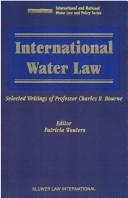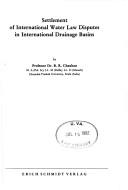| Listing 1 - 10 of 98 | << page >> |
Sort by
|
Book
ISBN: 9004438297 Year: 2020 Publisher: Leiden, Netherlands ; Boston, Massachusetts : Brill,
Abstract | Keywords | Export | Availability | Bookmark
 Loading...
Loading...Choose an application
- Reference Manager
- EndNote
- RefWorks (Direct export to RefWorks)
"Protection of water infrastructure is fundamental to the protection of civilians during armed conflicts; they provide water not only for drinking, but also for sanitation, agriculture and energy. Unfortunately, they suffer not only from incidental damages inherent in conflicts, but also from deliberate targeting and weaponization by the parties to conflicts. In The Geneva List of Principles on the Protection of Water Infrastructure, Tignino and Irmakkesen provide a detailed overview of the rules and practice on the protection of water infrastructure during and after armed conflicts. This overview is presented in a set of principles derived from different branches of international law and enriched with international practice, making the monograph a first in taking a holistic approach in the study of the subject"--
Book
Abstract | Keywords | Export | Availability | Bookmark
 Loading...
Loading...Choose an application
- Reference Manager
- EndNote
- RefWorks (Direct export to RefWorks)

ISBN: 9041107142 Year: 1997 Publisher: London : Kluwer law international,
Abstract | Keywords | Export | Availability | Bookmark
 Loading...
Loading...Choose an application
- Reference Manager
- EndNote
- RefWorks (Direct export to RefWorks)

ISBN: 3503019294 Year: 1981 Publisher: Berlin : Schmidt,
Abstract | Keywords | Export | Availability | Bookmark
 Loading...
Loading...Choose an application
- Reference Manager
- EndNote
- RefWorks (Direct export to RefWorks)
Book
ISBN: 9789004507623 9789004507616 Year: 2022 Publisher: Leiden; Boston : Brill
Abstract | Keywords | Export | Availability | Bookmark
 Loading...
Loading...Choose an application
- Reference Manager
- EndNote
- RefWorks (Direct export to RefWorks)
"Big Data Analytics and Its Impact on Basin Water Agreements and International Water Law represents the state of the art when it comes to the use of disruptive technologies in the transboundary water context and its impact on international water law. Indeed, the case study provided in this manuscript which represents the most relevant example where big data is being used in the transboundary water context highlights this reality. The readers will understand current and also future potential impact of big data on water resources in the general context of disruptive technologies"--
Book
ISBN: 9004402098 Year: 2019 Publisher: Leiden Boston : BRILL,
Abstract | Keywords | Export | Availability | Bookmark
 Loading...
Loading...Choose an application
- Reference Manager
- EndNote
- RefWorks (Direct export to RefWorks)
In Adapting Watercourse Agreements to Developments in International Law: The Case of the Itaipu Treaty Maria A. Gwynn offers an account of the need to align watercourses agreements to the current standards and principles of international law, thereby increasing prospects for achieving sustainable development. As a case study, the author focuses on the most important hydroelectrical energy treaty in the South American region and astutely explores its implementation together with states’ practices regarding the non-navigational uses of watercourses and their commitments to environmental protection. The analysis offers a unique opportunity to assess the value of the UN Watercourses Convention in recommending states adapt their agreements to the provisions of the convention promoting equitable and reasonable uses of watercourses; an interest not only for the treaty partners but also for river basin states and the international community as a whole.
Book
ISBN: 9004395482 Year: 2019 Publisher: Leiden ; Boston, MA : Brill,
Abstract | Keywords | Export | Availability | Bookmark
 Loading...
Loading...Choose an application
- Reference Manager
- EndNote
- RefWorks (Direct export to RefWorks)
Although the International Law Association (ILA) was established in 1873, it only turned its attention to the internationally shared water resources in 1954, when its half-century study of the applicable principles and rules of international law thereon began. The first ILA committee assigned to this task was the Rivers Committee, which, after a decade of intensive study and through several resolutions and statements, arrived unanimously at a set of articles reflecting customary international law, known as the Helsinki Rules on the Uses of the Waters of International Rivers . The Helsinki Rules, approved at the ILA 1966 Helsinki Conference, were soon widely accepted across the Globe as a non-binding authoritative source of international water law. This monograph traces the work of the ILA leading to the Helsinki Rules , analyses the Rules , and identifies their influence on and contribution to the evolution of international water law.
Book
ISBN: 9781138816909 1138816906 Year: 2015 Publisher: Abingdon: Routledge,
Abstract | Keywords | Export | Availability | Bookmark
 Loading...
Loading...Choose an application
- Reference Manager
- EndNote
- RefWorks (Direct export to RefWorks)
"The world's freshwater supplies are increasingly threatened by rapidly increasing demand and the impacts of global climate change, but current approaches to transboundary water management are unsustainable and may threaten future global stability and international security. The absence of law in attempts to address this issue highlights the necessity for further understanding from the legal perspective. This book provides a fresh conceptualisation of water security, developing an operational methodology for identifying the four core elements of water security which must be addressed by international law: availability; access; adaptability; and ambit. The analysis of the legal framework of transboundary freshwater management based on this contemporary understanding of water security reveals the challenges and shortcomings of the current legal regime. In order to address these shortcomings, the present mindset of prevailing rigidity and state-centrism is challenged by examining how international legal instruments could be crafted to advance a more flexible and common approach towards transboundary water interaction. The concept of considering water security as a matter of 'regional common concern' is introduced to help international law play a more prominent role in addressing the challenges of global water insecurity. Ways for implementing such an approach are proposed and analysed by looking at international hydropolitics in Himalayan Asia. The book analyses transboundary water interaction as a 'case study' for advancing public international law in order to fulfil its responsibility of promoting international peace and security"--
Water rights (International law) --- Right to water --- Water security
Book
ISBN: 1783476052 9781783476053 9781783476053 1783476052 Year: 2015 Publisher: Cheltenham: Elgar,
Abstract | Keywords | Export | Availability | Bookmark
 Loading...
Loading...Choose an application
- Reference Manager
- EndNote
- RefWorks (Direct export to RefWorks)
Water resources development --- Water --- Water rights (International law)
Book
Abstract | Keywords | Export | Availability | Bookmark
 Loading...
Loading...Choose an application
- Reference Manager
- EndNote
- RefWorks (Direct export to RefWorks)
| Listing 1 - 10 of 98 | << page >> |
Sort by
|

 Search
Search Feedback
Feedback About UniCat
About UniCat  Help
Help News
News